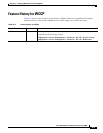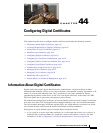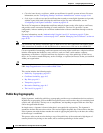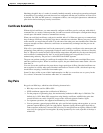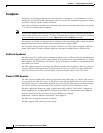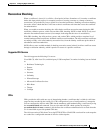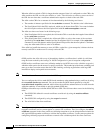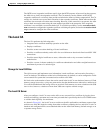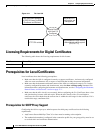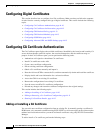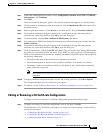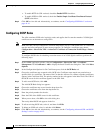
44-7
Cisco ASA 5500 Series Configuration Guide using ASDM
Chapter 44 Configuring Digital Certificates
Information About Digital Certificates
The OCSP server (responder) certificate usually signs the OCSP response. After receiving the response,
the ASA tries to verify the responder certificate. The CA normally sets the lifetime of the OCSP
responder certificate to a relatively short period to minimize the chance of being compromised. The CA
usually also includes an ocsp-no-check extension in the responder certificate, which indicates that this
certificate does not need revocation status checking. However, if this extension is not present, the ASA
tries to check revocation status using the same method specified in the trustpoint. If the responder
certificate is not verifiable, revocation checks fail. To avoid this possibility, use the revocation-check
none command to configure the responder certificate validating trustpoint, and use the revocation-check
ocsp command to configure the client certificate.
The Local CA
The local CA performs the following tasks:
• Integrates basic certificate authority operation on the ASA.
• Deploys certificates.
• Provides secure revocation checking of issued certificates.
• Provides a certificate authority on the ASA for use with browser-based and client-based SSL VPN
connections.
• Provides trusted digital certificates to users, without the need to rely on external certificate
authorization.
• Provides a secure, in-house authority for certificate authentication and offers straightforward user
enrollment by means of a website login.
Storage for Local CA Files
The ASA accesses and implements user information, issued certificates, and revocation lists using a
local CA database. This database resides in local flash memory by default, or can be configured to reside
on an external file system that is mounted and accessible to the ASA.
No limits exist on the number of users that can be stored in the local CA user database; however, if flash
memory storage issues arise, syslogs are generated to alert the administrator to take action, and the local
CA could be disabled until the storage issues are resolved. Flash memory can store a database with 3500
users or less; however, a database of more than 3500 users requires external storage.
The Local CA Server
After you configure a local CA server on the ASA, users can enroll for a certificate by logging into a
website and entering a username and a one-time password that is provided by the local CA administrator
to validate their eligibility for enrollment.
As shown in Figure 44-1, the local CA server resides on the ASA and handles enrollment requests from
website users and CRL inquiries coming from other certificate validating devices and ASAs. Local CA
database and configuration files are maintained either on the ASA flash memory (default storage) or on
a separate storage device.



